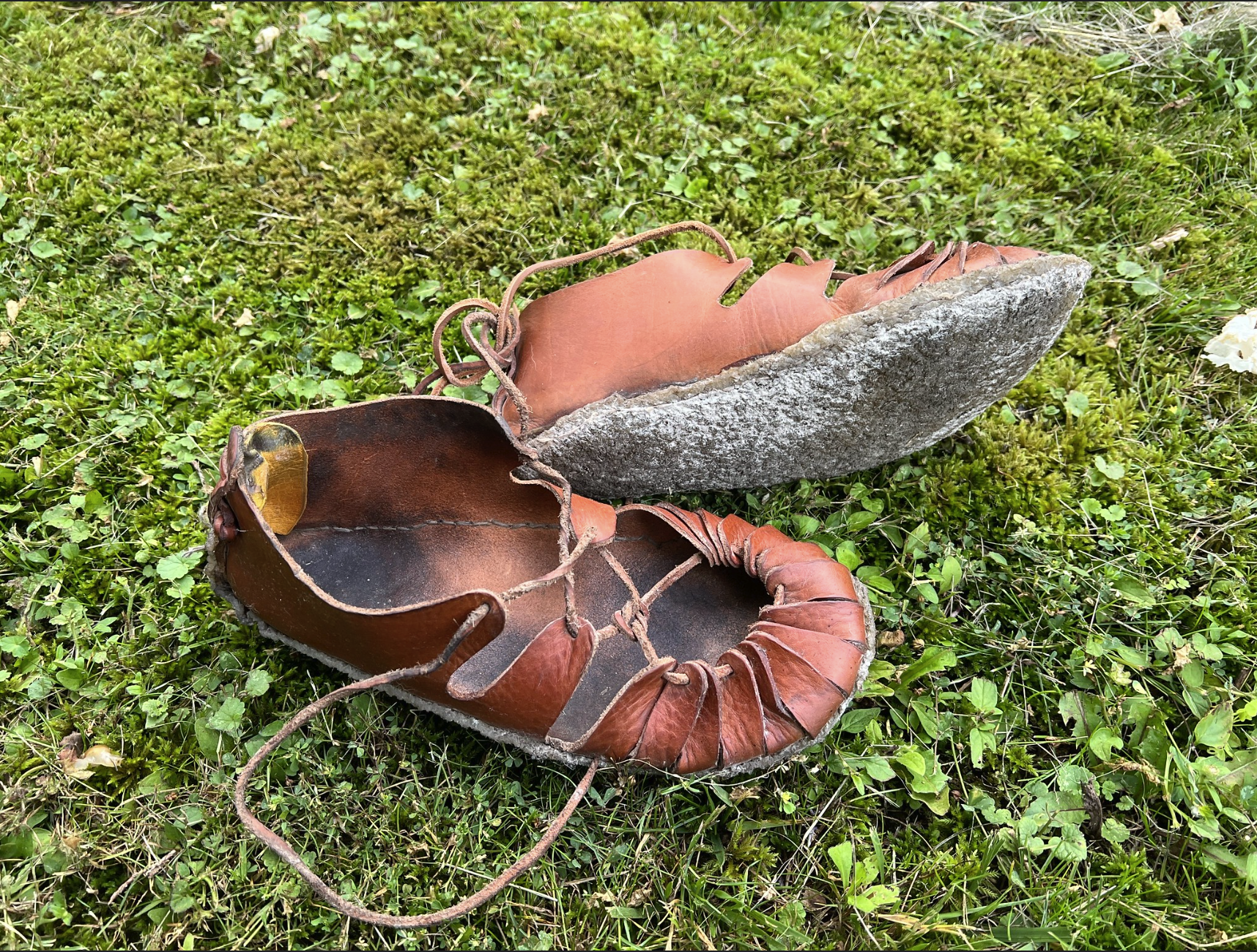One-piece shoes I created based on the 3rd-4th century shoes found at Obenaltendorf, Germany in 1895. Shoes of this type — represented by many finds from anaerobic bogs (so sometimes called “bog shoes”)— were used across Europe during the Iron Age & are related to ‘carbatinae’ worn by Roman provincials. Examples are highly diverse, with intricate patterns, but are united by their construction from a single piece of skin-product, laced together with minimal stitching. With evidence for more familiar sewn turn-shoes scarce across early Anglo-Saxon archaeology, with most remains belonging to the 7th century or later, it is likely that this earlier style of shoe from the Iron Age persisted well into the early Anglo-Saxon period, as represented by the one-piece shoe found in a late 6th century grave at Oberflacht, Germany.
These shoes were made from one piece of leather and feature tunnel stiching on the heel. Rather than be a direct copy of the Obenaltendorf pattern, they were adapted to my specific environment which has long tracts of gravel path. This was achieved by first drafting a pattern based on measurements of the foot and then adjusting the Obenaltendorf pattern around this to create a custom fit; a practice likely done historically. The mouldability of veg-tan leather ensures these shoes become more comfortable over time, though, lacking a thicker sole, they can wear out quickly without crepe rubber soles.
#anglosaxon #saxon #ironage #migrationperiod #vendelperiod #historiccostume #shoes #leatherwork #leather #craft #archaeology #livinghistory #reenactment #suttonhoo #merovingian #roman
These shoes were made from one piece of leather and feature tunnel stiching on the heel. Rather than be a direct copy of the Obenaltendorf pattern, they were adapted to my specific environment which has long tracts of gravel path. This was achieved by first drafting a pattern based on measurements of the foot and then adjusting the Obenaltendorf pattern around this to create a custom fit; a practice likely done historically. The mouldability of veg-tan leather ensures these shoes become more comfortable over time, though, lacking a thicker sole, they can wear out quickly without crepe rubber soles.
#anglosaxon #saxon #ironage #migrationperiod #vendelperiod #historiccostume #shoes #leatherwork #leather #craft #archaeology #livinghistory #reenactment #suttonhoo #merovingian #roman
One-piece shoes I created based on the 3rd-4th century shoes found at Obenaltendorf, Germany in 1895. Shoes of this type — represented by many finds from anaerobic bogs (so sometimes called “bog shoes”)— were used across Europe during the Iron Age & are related to ‘carbatinae’ worn by Roman provincials. Examples are highly diverse, with intricate patterns, but are united by their construction from a single piece of skin-product, laced together with minimal stitching. With evidence for more familiar sewn turn-shoes scarce across early Anglo-Saxon archaeology, with most remains belonging to the 7th century or later, it is likely that this earlier style of shoe from the Iron Age persisted well into the early Anglo-Saxon period, as represented by the one-piece shoe found in a late 6th century grave at Oberflacht, Germany.
These shoes were made from one piece of leather and feature tunnel stiching on the heel. Rather than be a direct copy of the Obenaltendorf pattern, they were adapted to my specific environment which has long tracts of gravel path. This was achieved by first drafting a pattern based on measurements of the foot and then adjusting the Obenaltendorf pattern around this to create a custom fit; a practice likely done historically. The mouldability of veg-tan leather ensures these shoes become more comfortable over time, though, lacking a thicker sole, they can wear out quickly without crepe rubber soles.
#anglosaxon #saxon #ironage #migrationperiod #vendelperiod #historiccostume #shoes #leatherwork #leather #craft #archaeology #livinghistory #reenactment #suttonhoo #merovingian #roman







